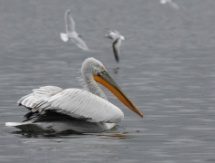

“Srebarna” Nature Reserve 18 km west of Silistra and 2 km south of the Danube. It comprises Lake Srebarna and its surroundings. The lake’s depth varies from 1 to 3 m and its area is 2-2.5 sq.m. During the warm season sometimes it turns into a swamp.
The lake is closely connected to Danube river. The total surface of the protected area is 901.2 hectares and it includes Devnya island and the Danube flow between the shore and the island.
There are several legends about the origin of the lake’s name. The one is about a khan named Srebrist, who died in the neighbourhood whilst engaging in an unequal battle with the Pechenegs. A second one tells about a boat full of silver (srebro in Bulgarian) along the shores of the lake. According to a third one, which is regarded as most plausible, the name comes from the silvery reflections on the lake’s surface during full moon. In the past the area was visited by Felix Kanitz, and in 1880 by another Austrian – Edward Hodek. He describes his impressions in the article “The house of the passing birds”.
The darkest page in the history of this beautiful area was written by Leo von Kalbermaten. He and his people sacrificed thousands of small and large herons. Women fashion of those times required the hats to be decorated with feathers from these birds. Another researcher, who visited Srebarna is Otomar Reiser. He is the author of “Ornis Bulgaria” whose second volume is dedicated to the Bulgarian fauna.
The first Bulgarian, who showed interest in this place is Alexi Petrov, who visited the reserve in 1911. He was fascinated by the beauty of the birds and planned a series of expeditions. He returned again, but only in 1940, because between 1913-1940 the Reserve along with the entire Southern Dobrogea was Romanian territory. Then Alexi Petrov restarted the study of the birds’ colonies that nested in the reserve.
Creating a single global network of biosphere reserves is part of the “Man and Biosphere” programme adopted in 1970 by UNESCO. In 1975 Lake “Srebarna” is subject to Ramsar Convention, and in 1983 was declared by UNESCO as World Heritage.
The lake is unique with its poisons floating in freedom, which in his movements alter the pattern formed by the water stains and vegetables. The view of the frozen lake in winter is inspirational, the mirror like surface being in contrast with the bright yellow reeds.
For nature lovers who want to experience the extraordinary beauty of the reserve are available several hiking trails passing along the borders of the protected area on the high hills of east, south and west. If you go on stunning views will be revealed. If you cross the border you can reach the eastern gateway to the south. You can also choose the west road near “Fountain” area to reach the banks of the Danube. The best view to the pelican colony opens at the top of “Kodzha hill”, which is located in the north – west of Srebarna.
In and around the lake there are reeds and other water plants. Reed occupies about 2/3 of the area of the reserve. Here we can find 139 species of plants, 11 of which are rare or endangered outside Srebarna. The second plant species as distribution is a thin sheet of rushes (Typhaangustifolia), followed by rush-leaved (Typhalatifolia). Gray willow (Salixcinerea) and red willow (Salixpurpurea) also widely disseminated.
The diversity of the birds is remarkable. The uniqueness of the reserve stays in the fact that it is located on the main migration route for the birds between Europe and Africa called VIA PONTIKA. The pearl of the reserve is the colony of Dalmatian pelicans.
230 bird species can be observed on the territory of the reserve (132 nesting and 98 spending the winter here). 3 of them are globally threatened species.
– Cormorant / Phalacrocoraxpygmeus /
– Dalmatian pelican / Pelecanuscrispus /
– Ferruginous duck / Aythyanyroca /
In Bulgaria the Dalmatian pelican and the great egret nest only in Srebarna.
